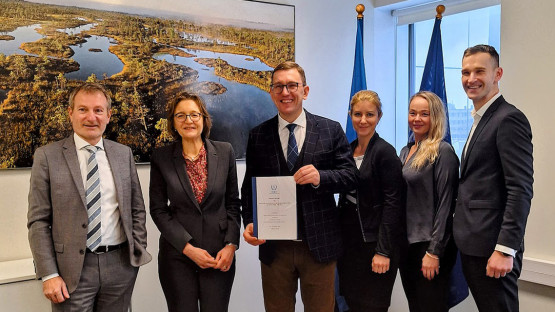The IAEA has handed over to Estonia the final report of a peer review mission that assessed the country’s development of the infrastructure needed for a safe, secure and sustainable nuclear power programme.
The Integrated Nuclear Infrastructure Review (INIR) mission was conducted from 23 to 30 October 2023 at the invitation of the Government of Estonia. An IAEA team of experts reviewed the status of nuclear infrastructure development as outlined for Phase 1 of the IAEA's Milestones Approach. This three-phased, comprehensive method guides countries in understanding the commitments and obligations associated with developing the necessary environment for a nuclear power programme and building a nuclear power plant.
Aline des Cloizeaux, Director of the IAEA’s Division of Nuclear Power, delivered the report to Estonian Climate Minister Kristen Michal on 16 January 2024 in Tallin. “The INIR mission concluded that the Government of Estonia is well organized in its preparations towards taking a decision on whether to launch a nuclear power programme to support the country’s just transition towards net zero carbon emissions,” des Cloizeaux said.
Estonia, seeking to reach net zero emissions by 2050 and bolster its energy security, is looking at nuclear power as a reliable and low carbon option to diversify its energy mix by 2035 when the country plans its phase-out of domestic oil shale. The plans for nuclear energy are focussed on small modular reactors (SMRs), which are attracting growing global interest due to their ability to meet the need for flexible and affordable power generation for a wider range of users.
The INIR mission team made several recommendations and suggestions to assist Estonia in making further progress in its nuclear infrastructure development, such as completing relevant plans and policies and considering further developing the legal and regulatory framework to support the next phase of the programme. The team also identified good practices in the areas of national position, human resource development and radioactive waste management.
“The feedback we received during the INIR mission from the IAEA experts is highly valued and supports the nuclear energy debate scheduled to take place in the Estonian Parliament in 2024,” Michal said. “This debate aims to determine whether our country is ready to initiate preparations for establishing an enabling regulatory environment for the deployment of nuclear energy, with the goal of achieving our 2050 climate targets and ensuring the security of electricity supply.”
Last month, Estonia published the final report of its Nuclear Energy Working Group, which will serve as the basis for the government’s decision on whether to proceed with a nuclear power programme. Should the government decide to embark on such a programme, Estonia and the IAEA will develop an Integrated Work Plan to identify IAEA activities to support Estonia’s efforts for further nuclear infrastructure development.
“Embarking on nuclear power is the sovereign decision of any country. The IAEA can provide the support but the major responsibility for moving the programme forward is with the country,” said des Cloizeaux. “The development of Estonia’s own human resources, skills and competence is an important factor for the sustainability of a nuclear power programme.”




